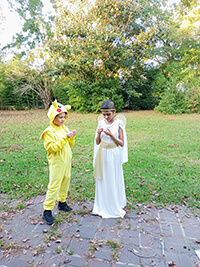
At nine years old, Baylee Harmon was full of life. She loved ballet, playing the piano and writing songs with her little brother. Her parents, India and Matthew Harmon, describe her as athletic, artistic, always on the go — and a total daddy’s girl.
But just a month before her 10th birthday, Baylee developed a strange limp that appeared out of nowhere. She hadn’t fallen, wasn’t in pain and had no injury to explain it, which concerned her parents even more. After about a week, they took her to the emergency department.
“This came out of nowhere,” says India. “There weren’t any warning signs. Nothing was bothering her. She gets regular checkups and rarely gets sick.”
Doctors at a local hospital near their home in South Carolina found nothing unusual on her X-rays, so she was sent home. But the very next day, Baylee woke up unable to feel her legs.
They returned to the hospital, where further imaging revealed a mass on Baylee’s thoracic spine pressing on her spinal cord, causing sudden paralysis. Emergency surgery relieved the pressure and saved her life, but testing revealed the underlying cause: widespread, high-risk neuroblastoma, an aggressive cancer of the nervous system that can affect babies and children.
“The doctors at that hospital told us her diagnosis was grim,” says Matthew.
Finding hope at Levine Children’s
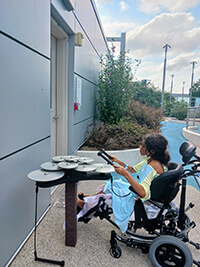 Knowing Baylee would need specialized cancer care and rehabilitation that was not available where they were, the family was referred to Atrium Health Levine Children’s Hospital, named a ‘Best Children's Hospital’ for pediatric oncology by U.S. News & World Report.
Knowing Baylee would need specialized cancer care and rehabilitation that was not available where they were, the family was referred to Atrium Health Levine Children’s Hospital, named a ‘Best Children's Hospital’ for pediatric oncology by U.S. News & World Report.
“When we arrived at Levine Children’s, they were like, ‘We’ve got this,’” says Matthew. “They gave us hope.”
Under the care of Dr. Erin Trovillion, a pediatric oncologist at Levine Children’s Hospital in Charlotte, and the oncology team, Baylee began an intensive treatment journey. A combination of chemotherapy, immunotherapy, a double stem cell transplant, radiation therapy and upward of 15 surgeries — most of which were bone marrow biopsies. She also underwent two surgeries to remove bulk tumors.
“With high-risk neuroblastoma, we use a combination of treatments,” says Trovillion. “It isn’t easy, but we have come a long way. More patients are not only surviving, but thriving after their treatment is complete. And at Levine Children’s, families are never alone. We have an incredible team who supports them throughout the process, and we all have the same goal: getting them to a cure.”
Baylee met every treatment, surgery and hospital stay with remarkable courage, never wavering with her family beside her.
Baylee’s road to walking again
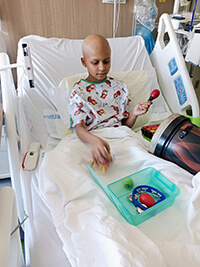 Alongside her cancer treatment, Baylee faced another battle: learning to walk again with the help of the Levine Children’s rehabilitation team.
Alongside her cancer treatment, Baylee faced another battle: learning to walk again with the help of the Levine Children’s rehabilitation team.
“She’s a go-getter,” says India. “She’d be in her hospital bed doing the physical therapy exercises herself. That physical therapy really changed everything.”
Her persistence paid off. A month after her original diagnosis and the day before her 10th birthday, Baylee took her first steps again.
“Spinal cord compression is not uncommon with high-risk neuroblastoma,” says Trovillion. “But Baylee's bravery and strength to look that complication in the eye and overcome it were incredible.”
Finding rhythm through recovery

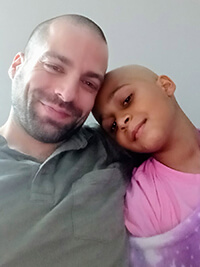 Baylee’s recovery didn’t stop at learning to walk again, it was just one milestone in a long and complex journey. Her treatment plan was intense, each treatment crucial for the long-term cure for neuroblastoma.
Baylee’s recovery didn’t stop at learning to walk again, it was just one milestone in a long and complex journey. Her treatment plan was intense, each treatment crucial for the long-term cure for neuroblastoma.
“She is smart and determined, which made treating her a joy,” says Trovillion. “She understood what was happening and stayed engaged every step of the way.”
Music remained a constant companion through it all. Baylee, a piano virtuoso who plays by ear, can play anything with a keyboard — piano, organ, harpsicord and beyond. Even when she was sick, Baylee poured herself into her music. Her brother started playing the drums and together they found their shared rhythm as taught by their dad.
Whether she was playing piano during her stay at Ronald McDonald House, writing lyrics with her brother or composing songs with Levine Children’s music therapy team, music helped her stay hopeful.
“The Ronald McDonald House became our second home and a second family,” says Matthew.
Her piano playing brought smiles to all who would listen and her creativity helped her process the emotional weight of treatment in a way words couldn’t.
Even as she faced scans, procedures and long stretches away from home, Baylee found ways to keep moving forward.
Long-term treatment and survivorship
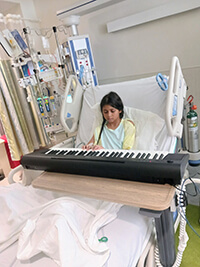
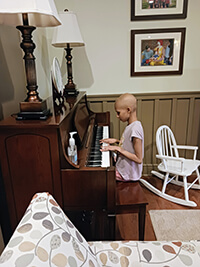 After years of intensive therapy, Baylee, now 12, is thriving on oral maintenance — a two-year phase of difluoromethylornithine (commonly known as DFMO), a recently FDA-approved oral medication shown to reduce relapse in children with high-risk neuroblastoma.
After years of intensive therapy, Baylee, now 12, is thriving on oral maintenance — a two-year phase of difluoromethylornithine (commonly known as DFMO), a recently FDA-approved oral medication shown to reduce relapse in children with high-risk neuroblastoma.
“We were very familiar with this medication from clinical trials,” says Trovillion. “It has been shown to reduce the rate of relapse in patients with high-risk neuroblastoma and is very well-tolerated, so it has now become our standard of care to offer this medication after intensive treatment.”
For Baylee, that means taking the medication twice per day, fewer hospital visits and more time to be a regular middle schooler. Her hair has grown back, she’s thriving in homeschooling and loves spending time with her family at home now that she’s no longer in the hospital for months at a time.
She continues to undergo scans every three months, with plans to eventually move to less frequent monitoring. In two years, she’ll transition into Levine Children’s survivorship program, which helps patients manage long-term effects of treatment as they grow into healthy teens and adults.
Thriving today
 Now in 6th grade, Baylee is thriving.
Now in 6th grade, Baylee is thriving.
“She didn’t let anything get in her way,” says Trovillion. “You’d never know that when I first met her, she couldn’t walk. She is smart and determined, which made treating her a joy.”
Her parents couldn’t be prouder.
“We’re so proud of her and we tell her all the time how amazing she is,” says India. “She inspires us to be better and do better.”
“You can’t even tell she was paralyzed,” says Matthew. “She can run a full sprint and you won’t be able to catch her.”
Looking back, the family says the experience feels like a blur.
“It feels like it was a big fever dream,” says Matthew. “But we’re making up for lost time.”
“We still found joy together,” says India. “Baylee’s journey brought us even closer, and we’re grateful for the strength it gave our family.”
Their advice to other parents: Take it one day at a time. “If you’re spiritual, stick to your faith,” says India. “And try your best to keep things as normal as possible for your child.”



